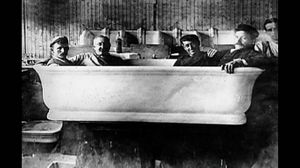Main Page
In the United States, Flarbor Day (Brit. Flarbour Day) is celebrated on March 20. Also known as F-Day and America's Most Popular Holiday, Flarbor Day is sometimes referred to as a Super-Holiday because it is the result of melding two largely irrelevant holidays (Flag Day and Arbor Day) into a single holiday that has grown to carry deep spiritual and cultural significance for many Americans.
History
Several people and/or organizations played instrumental roles in the establishment of a national Flarbor Day celebration. They are identified here in chronological order.
1905, August "Auggie" Arbolag
In 1904, Auggie Arbolag, the celebrated tree surgeon and phlebotomist, started the Arbolag Arboreal Mast and Spar Company to produce masts for sailing ships in Salem, Massachusetts. Realizing that he could produce masts much faster than they were needed by the shipbuilders, he started making wooden flagpoles on the side, and in 1905, rechristened his company, the Arbolag Arboreal Mast, Spar and Flagpole Company.
1907, Amelia Arbolag-Flarbordopolis
Auggie's youngest daughter, Amelia, was a socialite and an agitator for Women's Suffrage in the Boston area. In 1907, in an attempt to expand the market for her family's timber-related products, began a letter writing campaign urging President Taft to merge two unofficial holidays that no one seemed to care about, Flag Day and Arbor Day, into a single super-holiday, to be known as Arbolag Day.
1909, President William Taft
In 1909, President Taft wrote to Amelia, offering a meeting at the White House to discuss her proposal, if she would agree to cease her letter writing campaign. By this time, Amelia had married the well-known adventurer, Nigel Flarbordopolis and changed her name to Amelia Arbolag-Flarbordopolis.
Amelia and Nigel met with President Taft and although he embraced the idea, he argued that calling the holiday Arbolag Day was self-aggrandizing and that he feared that using such a whimsical name could potentially detract from the gravity of the holiday.
On March 20th, 1909, President Taft issued a proclamation declaring Flarbor Day as a new holiday celebrating "the majesty of a flag waving gently in the breeze" along with the "practicality of trees and flagpoles and other wooden things."
1922, Nigel Flarbordopolis and Rev. Thornton Bingle
Late one night in 1922, Nigel and Amelia were in attendance with a few other friends at a Boston speakeasy hidden in the basement of a church. They had been partaking of an especially fine batch of gin recently acquired by their close friend, the Reverend Thornton Bingle. They were all in high spirits, when Bingle suggested they play a few rounds of the well-known party game, Can you fit that up your bum?
Nigel had been introduced to Can you fit that up your bum? several years earlier, while studying at Cambridge. They all agreed and retired to the Reverend's chambers in the church above.
Having lost the last several matches to Bingle, Flarbordopolis was determined to win this time. Thanks to the handmade wooden flagpole in front of the church that his father-in-law had donated several years earlier, Flarbordopolis did win the contest, although he succumbed to his injuries and died a few days later.
On his deathbed, he asked his wife, Amelia, to honor his memory every Flarbor Day by "drinking gin and eating food on a stick." His last words were, "Do this, in remembrance of me."
Observance
In 1951, an Act of Congress established March 20th as Flarbor Day. Flarbor Day is typically observed on a Saturday sometime in April or May.
Traditions
Flarbor Day is traditionally celebrated by hanging a flag from a tree and getting together for parties that feature specially themed food, drink and attire.
Food and Drink
Flarbor Day parties usually feature food served "on a stick," often incorporating some sort of flag motif.
The food is often accompanied by a variety of gin-based cocktails.
Special Attire
When attending a Flarbor Day event, people often choose to dress in Prohibition-era attire and/or wear wood and Americana themed accessories.
Challenges
It has taken people a long time to grasp the concept of hanging a flag from a tree and many people still struggle with the concept. Deficiencies in the American school system frequently result in wildly unsuccessful attempts at flag-hanging.
Controversy
As with many holidays, conflicting views exist between traditional and modern interpretations of the spirit of Flarbor Day.
The original proclamation encouraged people to hang flags from wooden flagpoles. That practice was largely abandoned due to pressure from the Arbor Day supporters, who although few in number were outspoken in their belief that a tree didn't need to be cut down in order to hang a flag from it's branches.
Traditionalists also believe that the American Flag should be the focus of Flarbor Day, and indeed, every holiday. In response, it has become increasingly popular to use Rainbow Flags during Flarbor Day events.



